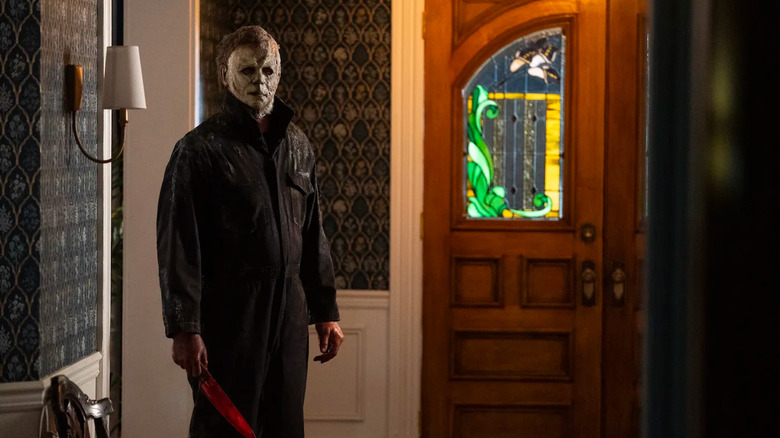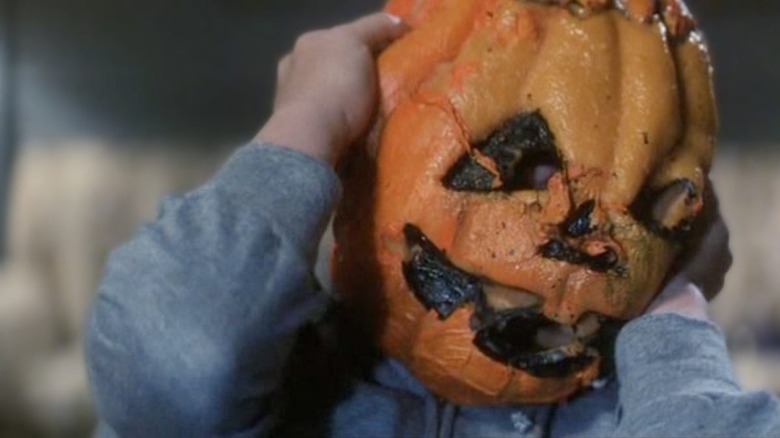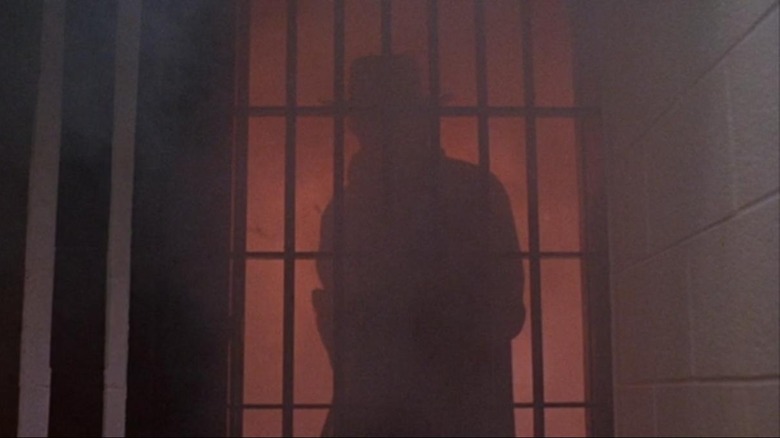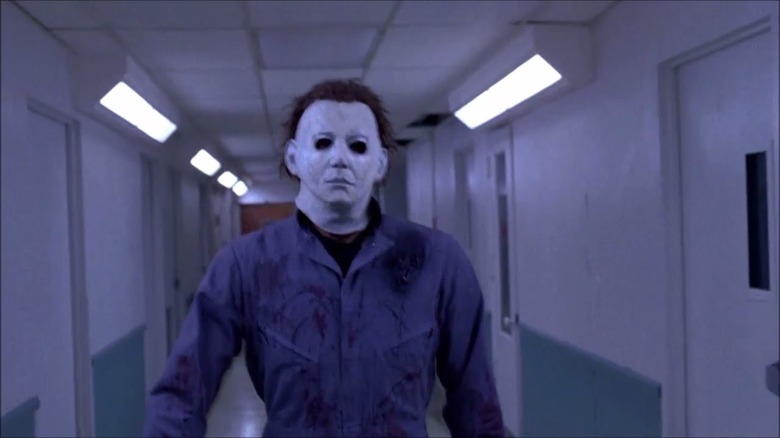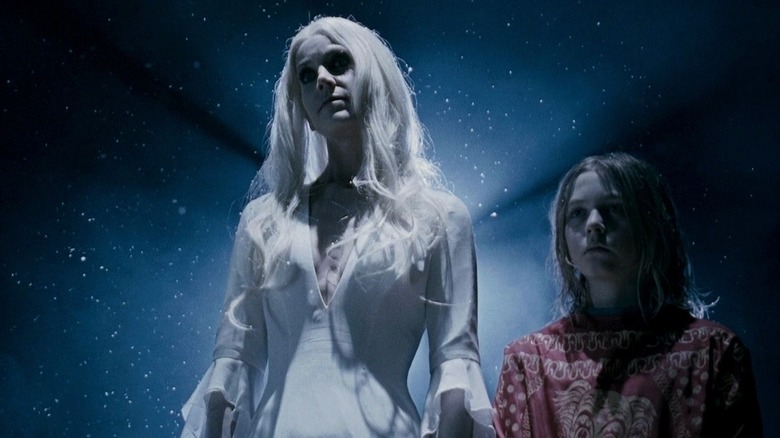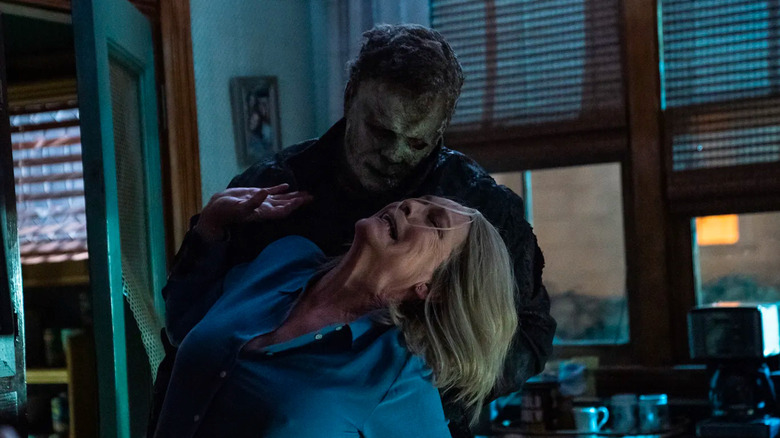Halloween Ends Is Another Reminder Of The Flexibility Of The Halloween Franchise
Spoilers for the "Halloween" franchise, including "Halloween Ends," follow.
"Halloween Ends," the latest (and possibly last?) entry in the "Halloween" franchise, goes to unexpected places. It takes big swings, introduces new characters, and unfolds in a fairly unpredictable manner. Some have taken issue with such drastic changes, but here's the thing: big, weird swings are nothing new for the "Halloween" series. Indeed, part of what makes the "Halloween" franchise so memorable is its flexibility — Michael Myers' never-ending murder quest has been shaped and reshaped in different ways through a score of films (hell, one of those films doesn't even feature Michael Myers).
And that's part of the fun. If you're a fan who only wants these films to play the hits — The Shape stalking teens through Haddonfield — there are multiple movies that offer that. But there's something to be said for the out-there, unconventional, big-swing "Halloween" movies. Movies that take that familiar formula and smash it to bites, asking if we'd like to see something new. As moviegoers, we should want that sort of variety. We should embrace it, even if it doesn't always work. And that's what thrilled me about "Halloween Ends," which is arguably the most interesting (notice I didn't say best) "Halloween" sequel since "Halloween III: Season of the Witch."
It means the death of millions of people
By all accounts, "Halloween" creators John Carpenter and Debra Hill were not happy with "Halloween II." Carpenter reportedly was only able to get the script done while writing drunk, and the end result was a direct sequel (set only minutes after the first film ends) that felt like more of the same. Carpenter and Hill wanted something different. So when it came time to make a third "Halloween" film, Carpenter and Hill struck upon a novel idea — a "Halloween" sequel that would have nothing to do with Michael Myers or Haddonfield. The concept was to turn "Halloween" into a kind of brand — there would be a new "Halloween" film every year that used the title and the Halloween season setting, but each film would stand on its own and have nothing to do with Michael Myers. In retrospect, it sounds like a great concept. A "Halloween" anthology film series! And at the time, producers Irwin Yablans and Moustapha Akkad went along with the idea. But their enthusiasm didn't last very long.
Trading Illinois for Northern California, "Halloween III" introduces us to Dan (Tom Atkins), a doctor who loves chugging beers and trying to pinch the bottoms of the women he works with (and he's supposed to be our hero, folks). After the strange, gruesome murder of a patient, Dan meets up with Ellie (Stacey Nelkin), the dead man's daughter. She's much younger and much more attractive than he is. Naturally, they fall into bed together almost instantly. Then they head to a small town known as Santa Mira, home of Silver Shamrock Novelties. Ellie suspects the company and their three new Halloween masks have something to do with her father's death. And she's right. The company's owner, the slick Conal Cochran (a delightfully wicked Dan O'Herlihy) has stolen one of the slabs from Stonehenge (yes, really) and is using it to turn the three Silver Shamrock masks into ticking time bombs. If anyone wearing the mask watches a signal beamed out from Silver Shamrock, they meet with a horrible end that involves bugs and other creepy crawly things exploding from their heads.
As you can tell from that write-up, none of this has anything to do with Michael Myers. And audiences who had already grown accustomed to The Shape were not happy about that. The film flopped and almost immediately developed a reputation as a "worst of the series" entry. I'll admit that when I was a kid and rented "Halloween III" from the video store, I was perplexed. Where the hell was Michael Myers? Over the years, though, my opinion changed — and I wasn't alone. Because once you get over the lack of Michael Myers, "Halloween III" is a nifty little horror movie. I love the Halloween season vibes it throws off. And I love how comically nasty it all is — the villain wants to murder every child in the world with Halloween masks. That's both gruesome and darkly funny.
Moving forward, the producers insisted all "Halloween" sequels feature Michael Myers, killing the anthology idea and causing Carpenter and Hill to walk from the series (Carpenter would not return in any official form until 2018's "Halloween"). But the thing is, if the film had just been called "Season of the Witch" instead of "Halloween III: Season of the Witch," the anthology idea might've lasted a little longer. Because I know I definitely want a whole series of movies like this; movies that are set on Halloween but tell completely different creepy stories. Alas, that wasn't to be for the "Halloween" franchise. But that didn't mean the series couldn't still get weird.
Here comes the Man in Black
In the wake of "Season of the Witch," franchise producer Moustapha Akkad insisted on bringing back Michael Myers for future installments. And so, "Halloween 4" became "The Return of Michael Myers," with the Shape returning to Haddonfield to murder everyone in his path. This time, Michael learns he has a niece (the daughter of Laurie Strode, who we learn died in a car accident, although "Halloween H20" reveals that Laurie faked her death to go into hiding, and apparently never contacted her daughter again). Obsessed with bumping off his bloodline, Michael goes after the child, Jamie (Danielle Harris). The film ends with a chilling moment where we see Jamie murder her stepmother, suggesting Michael's evil has been passed down.
But then "Halloween 5: The Revenge of Michael Myers" ruins all that. We learn Jamie's stepmother survived, and Jamie is being treated for her problems in a clinic. Of course, Michael is still out there. For the most part, "Halloween 5" follows the same formula as "Halloween 4," but creeping in the background are hints of something stranger. As Michael goes about his killing spree, Jamie keeps having visions of a mysterious Man in Black. Who is he? Johnny Cash? A ghost? An old-timey gangster who found a time machine? Whoever he is, the film ends with the Man in Black killing off Haddonfield's cops and springing Michael from jail. That's right: Michael has a new buddy! It won't be the first time he teams up with someone.
You can't control evil
The sixth film, "Halloween: The Curse of Michael Myers," is notorious for being chopped to hell before release — there are numerous alternate cuts, including "The Producer's Cut," which is considered as close to the original version of the film as possible. It's here where "Halloween" gets even weirder than before. We learn that Michael has taken up with a cult known as the Cult of Thorn. Thorn is also a curse — and the explanation given for why Michael is obsessed with murdering his bloodline. He's cursed to do it! And oh yeah, the Man in Black turns out to be Dr. Wynn, an old pal of Michael's psychiatrist and arch-enemy Dr. Loomis.
It's messy and doesn't make much sense. Why is there an evil cult working with Michael Myers now? Why is Dr. Loomis, who seemed pretty dead at the end of "Halloween 5," still kicking around? Why is Paul Rudd in the movie? These are mysteries, and none of them have satisfying answers. But once again, there's an attempt to explain Michael. He's not just evil — he's part of some weird cult! While I don't love any of this, I appreciate it. It's a big swing, and that's commendable, if not successful. And there's something fascinating about writers and directors trying to explain Michael Myers and his evil. It almost never works, and yet filmmakers keep trying. Filmmakers like Rob Zombie.
Only a river of blood can bring us back together
After two more lackluster sequels — "Halloween H20" and "Halloween: Resurrection" — the franchise went quiet for a little bit. A remake was all but inevitable, and sure enough, Rob Zombie ended up helming a remake in 2007. Zombie is a great filmmaker from a visual standpoint. But he's not the best storyteller — his scripts are weak, suffering from terrible dialogue and muddled plotting.
Zombie's "Halloween" remake is a strange beast. The second half of the film is more or less a beat-for-beat remake of John Carpenter's original. But the first segment of the flick tries to act as a kind of prequel, delving into Michael Myers' childhood. And Zombie stumbles, significantly. What made Michael Myers so scary in the original "Halloween" was that there was no explanation for his evil. He was just a living, breathing killing machine, unsympathetic and unstoppable. In Zombie's hands, we learn Michael was a lonely, troubled kid who suffered abuse, only to grow into a hulking monster.
It's a bad movie, folks. And yet, Zombie came back for a sequel that completely flipped the script and resulted in one of the best "Halloween" films. Zombie's "Halloween II" abandons any pretense of trying to recreate what Carpenter did. Instead, Zombie stages a strange, haunting, incredibly violent saga full of ghosts and fairytale-like nightmares. Michael Myers mostly stalks around in the background while his sister Laurie (a miscast Scout Taylor-Compton) goes absolutely insane. Full of the type of occult-like imagery Zombie does so well, "Halloween II" is an unnerving film that does a better job exploring trauma than the new trilogy, which practically screams "THIS IS ABOUT TRAUMA!" in your face every few minutes.
The story as we told it was to fade with time
After several years, it was time to reboot "Halloween." David Gordon Green and his team came up with a somewhat novel idea: they would ignore every single "Halloween" movie except the first one. Not even "Halloween II," which revealed Michael Myers and Laurie Strode were long-lost siblings, remained in canon. Instead, Laurie's only confrontation with the Shape was that one Halloween night, ending with the mysterious figure shot by Dr. Loomis, only to escape into the night.
Green's first film, simply titled "Halloween," doesn't really change much, formula-wise. Once again, it's Halloween night, and Michael Myers is murdering the folks of Haddonfield as he gets closer and closer to Laurie Strode (Jamie Lee Curtis). The film serves as a nice little conclusion to Laurie's story, with the character taking back her own narrative. It feels concise and final. But of course, there's franchise money to be made here!
"Halloween Kills," the next film, is a big, stupid mess that feels completely unnecessary. The only thing you need to know about the film is that it's ultra-violent and features characters yelling "Evil dies tonight!" over and over again. In short, it's bad. And as a result, I was nervous about "Halloween Ends," the final film in the franchise. But I was wrong, as "Halloween Ends" is one of the most interesting sequels in the history of the franchise. Outside of "Season of the Witch," it's the film that takes the biggest swings. Michael Myers spends the majority of the film off-screen, hiding out in the sewer. Instead, the story focuses on Corey Cunningham (Rohan Campbell), a character who seems heavily inspired by Arnie Cunningham, a character in John Carpenter's Stephen King adaptation "Christine."
Corey is introduced as a nice guy who accidentally kills a kid while babysitting. While Corey doesn't end up in jail (it was an accident, really), he becomes the town pariah mocked and hated at every turn. After a run-in with Michael Myers in the sewer, Corey begins to change, as if just coming in contact with Michael is enough to turn a person to evil. It's all part of Green's concept that the evil of Michael Myers is like a disease; a thing that can infect others. And for a while there, it looks like Michael and Corey are a team, until, of course, Michael grows tired of that and eventually murders Corey. But not before Corey hooks up with Laurie Strode's granddaughter, the increasingly disturbed Allyson (Andi Matichak). The Corey/Allyson romance is almost like something out of "Twin Peaks" — greaser punk falls for a normal girl who isn't so normal; sparks fly; death follows.
At the same time, this is the story of an angry incel-type character who slowly dissolves into murder. You could argue Corey is a good guy gone bad, but you could also argue that anyone who turns into a masked serial killer at the drop of a hat wasn't really a good guy, to begin with. This is weird, unique stuff for a "Halloween" entry, and while I understand people being angry at sidelining Michael, I think it works. It also ties into Laurie's narrative. She's tried to change into a generic grandma, baking pies and wearing aprons. But she can't escape her past or her guilt, and it all builds towards a truly final confrontation where she obliterates Michael and the whole town turns out to watch his body be thrown into a car crusher.
Again: I get not enjoying any of this. But here's the thing: if you just want something familiar, aka Michael Myers stalking Laurie and company, there are several films that do that already. And I genuinely think what Green is doing here is worthwhile for its differences. The ultimate death of Michael is built firmly Green's trilogy narrative, which argues that as good as the folks of Haddonfield think they are, they're still bloodthirsty. They can claim to want to watch Michael die to feel safe again, but there's a darkness in this act of mob justice. But Green still manages to give us a remarkably sweet, emotional ending.
The first "Halloween" ends with Carpenter filming various locations throughout the film. Dark and empty, we can hear Michael breathing over them, implying he's everywhere, haunting everyone forever. In "Halloween Ends," Green does something similar. But instead of cutting to darkened scenes of murder, he cuts around to sunlit rooms. And instead of Michael's ominous breathing, we hear birds singing. There's hope here. And yet ... we get a glimpse of Laurie's home office and see that Michael's mask is sitting on her coffee table. Perhaps it's just there as a reminder.
Or perhaps it's waiting for someone else to pick it up.
